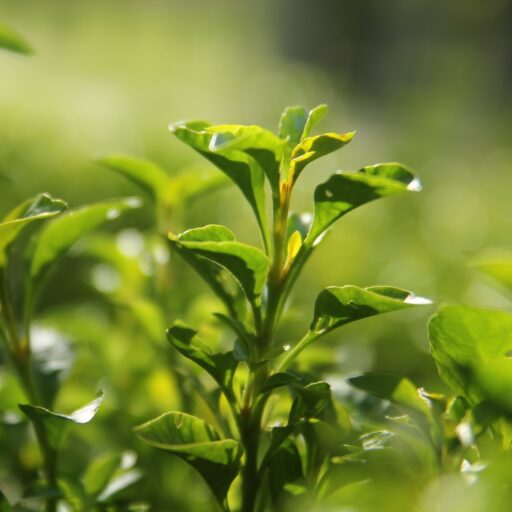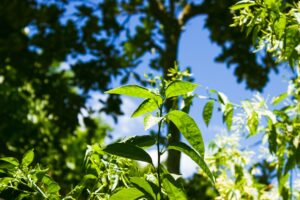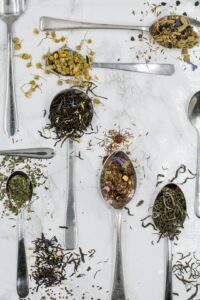Support our educational content for free when you purchase through links on our site. Learn more
🌿 Grow Your Own Tea Garden: 10 Steps to Brewing a Cup of Homegrown Bliss [2024]
Dreaming of a cup of tea brewed with leaves from your very own garden? We’ve got you covered. Sure, you can buy a bag of tea at the store, but there’s something special about harvesting your own tea leaves and transforming them into a delicious brew. Like the time I discovered a tiny tea plant growing wild in my backyard. It was like a tiny green treasure waiting to be unearthed. We’re the tea growers at Growing Teas™, and we’re ready to share our expert advice on cultivating your own tea garden. Ready to sip on some homegrown goodness? Let’s get started!
Quick Answer:
Here are the key takeaways from our guide to growing your own tea:
- Choose the right tea plant: Camellia sinensis is the most popular variety.
- Sunlight is essential: Opt for a location with at least 6 hours of direct sunlight.
- Well-drained soil: Tea plants prefer acidic soil with a pH range of 4.5 to 6.5.
SHOP RELATED PRODUCTS:
Table of Contents
- Quick Tips and Facts 🍵
- The Origins of Tea: A Journey Through History 🌏
- Cultivating Your Own Tea Garden: A Step-by-Step Guide 🌱
- Choosing the Perfect Tea Plant for You 🌿
- Sunlight and Soil: Essential Elements for Tea Plant Growth ☀️ 🌎
- Watering Your Tea Plants: A Balancing Act 💧
- Fertilizing Your Tea Plants: A Boost for Growth 💪
- Pruning Your Tea Plant: A Sculpting Art ✂️
- Harvesting Your Tea Leaves: Time to Sip and Savor 🍂
- Processing Your Harvest: From Leaf to Cup ☕️
- Pests and Diseases: Protecting Your Tea Plants 🐛
- Winter Care for Your Tea Plants: A Cozy Season ❄️
- Beyond the Basics: Exploring Different Tea Varieties 🗺️
- A Tea Lover’s Guide to Companion Planting 🤝
- Conclusion 🏁
- Recommended Links 🔗
- FAQ ❓
- Reference Links 📚
Quick Tips and Facts 🍵
Have you ever dreamed of brewing a cup of tea made from leaves you grew yourself? It’s more achievable than you might think! We’re the tea growers at Growing Teas™, and we’re sharing our expertise to help you cultivate your own tea garden. Here are a few quick tips to get you started:
- Choose the right plant: While there are many types of tea plants, the most common is Camellia sinensis. This species is known for its versatility and adaptability to different climates.
- Sunlight is key: Tea plants thrive in full sun or partial shade. Ensure your chosen spot receives at least 6 hours of direct sunlight daily.
- Well-drained soil: Tea plants need soil that allows water to flow freely. Avoid soggy conditions that can lead to root rot.
- Patience is a virtue: Tea plants need a few years to mature and produce a good harvest. Don’t be discouraged if you don’t see results immediately!
Pro Tip: Did you know that tea plants can live for decades? With proper care, you can enjoy fresh tea for years to come.
The Origins of Tea: A Journey Through History 🌏

The story of tea is an enchanting tale of cultural exchange and discovery, stretching back over 5,000 years! Legend has it that tea was first discovered in China when Emperor Shennong accidentally drank a cup of boiled leaves that had fallen into his water.
From humble beginnings, tea quickly became a cherished beverage across Asia. It was widely consumed in monasteries and became a vital part of religious ceremonies. Over time, tea spread across the globe, reaching India, the Middle East, and eventually Europe. The British Empire played a pivotal role in the tea trade, establishing vast plantations in India and Sri Lanka. Today, tea cultivation is a multi-billion-dollar industry, with major producers including China, India, Sri Lanka, and Kenya.
Fun Fact: The average Brit drinks more tea (per capita) than 23 Italians! 🍵🇮🇹
- Learn more about the history of tea: History of Tea
Cultivating Your Own Tea Garden: A Step-by-Step Guide 🌱
Ready to embark on your tea-growing journey? Let’s dive into the details:
1. Choosing the Perfect Tea Plant for You 🌿
Picking the perfect tea plant depends on your climate and desired tea type.
- For a classic tea experience: Camellia sinensis var. sinensis is the popular choice. This variety produces the traditional black, green, and oolong teas we know and love.
- If you prefer a stronger flavor: Consider Camellia sinensis var. assamica, which produces a bolder, more robust tea.
Our Recommendation: Start with a small sapling or a potted tea plant. It’s easier to manage than starting from seed and will give you a head start.
2. Sunlight and Soil: Essential Elements for Tea Plant Growth ☀️ 🌎
- Sun: Tea plants love sunshine! Choose a location with at least 6 hours of direct sunlight per day.
- Soil: Tea plants prefer acidic soil with a pH range of 4.5 to 6.5. If the pH is too high, it can affect the tea plant’s growth and flavor.
- Test your soil: 👉 CHECK PRICE on: Amazon | Walmart | Home Depot
- Amend the soil: If your soil is not acidic enough, you can add peat moss, pine bark, or composted leaves to adjust it.
3. Watering Your Tea Plants: A Balancing Act 💧
Water is essential for tea plant growth. Follow these tips for optimal hydration:
- Consistency: Water regularly, but avoid overwatering. Let the top inch of soil dry out before watering again.
- Deep watering: Instead of shallow watering, give your plants a deep soak each time. This encourages root growth and prevents dryness.
- Observe the soil: Check the soil frequently, especially during hot weather. The soil should feel moist, not drenched.
4. Fertilizing Your Tea Plants: A Boost for Growth 💪
A little TLC can go a long way!
- Organic fertilizer: Choose an organic fertilizer specifically designed for acid-loving plants.
- Timing: Fertilize in the spring and early summer when the plant is actively growing.
- Frequency: Fertilize every 4-6 weeks.
- Avoid over-fertilizing: Too much fertilizer can burn the roots. Follow the instructions on the packaging carefully.
5. Pruning Your Tea Plant: A Sculpting Art ✂️
Pruning your tea plant helps it to grow bushier and produce more leaves.
- Timing: The best time to prune is late winter or early spring before the new growth starts.
- Technique: Remove dead, damaged, or overgrown branches. You can also shape your tea plant by pruning the top and sides.
- Harvesting: After pruning, wait for a few weeks before harvesting leaves to allow the plant to recover.
6. Harvesting Your Tea Leaves: Time to Sip and Savor 🍂
This is the moment you’ve been waiting for!
- Timing: Harvest the leaves when they are young and bright green. Look for leaves that have just opened, as they are typically more flavorful.
- Method: Pluck the top two leaves and the bud (the tiny leaf tip) from each branch.
- Timing for Different Teas:
- Green tea: Harvest leaves in the early morning before the sun gets too strong.
- Black tea: Harvest leaves as they mature in the later stages of the growing season.
- Oolong tea: This tea blends the characteristics of green and black tea. Harvest leaves at different stages of maturity to achieve a unique flavor profile.
7. Processing Your Harvest: From Leaf to Cup ☕️
Once you’ve harvested your tea leaves, it’s time to process them into a delicious brew.
- Green tea: The simplest method is steaming the leaves for a few minutes, to halt oxidation and preserve their bright green color and fresh grassy flavor.
- Black tea: Black tea is oxidized and fermented. This process involves withering the leaves in the sun or air, then rolling them to release their juices. Oxidation gives black tea its dark color and robust flavor.
- Oolong tea: This tea is partially oxidized. The extent of oxidation influences its flavor.
Our Recommendation: For a beginner tea grower, green tea is the easiest to process.
- Check out our step-by-step guide to processing green tea: Green Tea Processing Guide
8. Pests and Diseases: Protecting Your Tea Plants 🐛
Tea plants are generally hardy, but some pests and diseases can cause problems.
-
Common pests: Aphids, spider mites, and scale insects can damage your tea plants.
-
Common diseases: Leaf spot, root rot, and fungal diseases can be troublesome.
-
Prevention:
- Select healthy plants: Choose disease-free saplings or potted plants to start with.
- Good air circulation: Space your plants properly to promote airflow and prevent fungal growth.
- Regular inspection: Check your plants regularly for signs of pests or diseases.
- Organic solutions: Use organic pesticides and fungicides to control pests and diseases.
9. Winter Care for Your Tea Plants: A Cozy Season ❄️
- Cold tolerance: Tea plants can tolerate mild winters. But if you live in a region prone to harsh frosts, you’ll need to take extra care to protect your plants.
- Protection: Bring potted plants indoors or cover them with a frost blanket. If you’ve planted your tea plant outdoors, you can create a protective barrier using burlap or straw.
- Dormant season: During the winter, your tea plant will become dormant and stop growing. This is a natural process and nothing to worry about.
10. Beyond the Basics: Exploring Different Tea Varieties 🗺️
Tea has a rich and diverse world, with many varieties to discover:
- Black tea: A widely popular choice known for its bold and robust flavor.
- Green tea: Known for its delicate and grassy flavor. Green tea undergoes minimal oxidation.
- Oolong tea: A semi-oxidized tea with a flavor that falls somewhere between black and green tea.
- White tea: The least processed tea, with a light and sweet flavor.
- Herbal tea: Made from herbs and flowers, not from the Camellia sinensis plant.
Our Recommendation: Join our Tea Market Trends newsletter to stay informed on the latest tea trends and discover new varieties.
11. A Tea Lover’s Guide to Companion Planting 🤝
- Benefits: Companion planting involves growing different plants together to benefit both plants and the environment.
- Tea plant partners:
- Rosemary: This herb repels pests, and its strong aroma can help mask the scent of the tea plant, making it less attractive to insect pests.
- Lavender: Lavender is also known to repel pests and adds a touch of beauty to your tea garden.
- Mint: Mint is a great companion plant for many gardens and can help improve the soil.
Our Recommendation: Learn more about Herbal Tea Planting.
Conclusion 🏁

Growing your own tea plants is a rewarding experience. You can enjoy the satisfaction of nurturing your own tea garden and savoring the unique flavors of fresh-brewed tea. Remember to be patient, observe your plants closely, and experiment with different varieties. With proper care and attention, you can cultivate a thriving tea garden that delights your senses for years to come.
We invite you to join the Growing Teas™ community! Share your tea-growing journey with us and connect with other tea enthusiasts.
Recommended Links 🔗
SHOP RELATED PRODUCTS:
- Camellia sinensis saplings: Amazon | Walmart
- Soil pH test kits: Amazon | Walmart
- Organic fertilizers: Amazon | Walmart
- Organic pesticides: Amazon | Walmart | Etsy
- Organic fungicides: Amazon | Walmart | Etsy
- Frost blankets: Amazon | Walmart
- Burlap: Amazon | Walmart
- Straw: Amazon | Walmart
- Tea making tools: Amazon | Walmart
RECOMMENDED BOOKS:
- The Tea Lover’s Companion: A comprehensive guide to everything tea.
- The Encyclopedia of Tea: Delve into the world of tea, from its history to cultivation.
FAQ ❓

Can you grow a tea plant in your house? 🤔
Yes, you can grow a tea plant indoors, but it will need a lot of light. Place it near a sunny window or use a grow light. Keep the soil moist but not soaked. You may also need to raise the humidity to keep your tea plant happy. Learn more here.
What is the best tea to grow? 🌱
The “best” tea to grow depends on your personal preference, but Camellia sinensis is a great choice for beginners. It is a versatile plant that can be grown in various climates. Consider the different varieties – Camellia sinensis var. sinensis for classic tea, or Camellia sinensis var. assamica for a bolder flavor.
Can you grow tea in the US? 🇺🇸
Yes, you can grow tea in the US! While it’s native to warmer climates like Asia and India, some areas in the US are suitable for tea cultivation. The Pacific Northwest, particularly in areas like Oregon, has a climate similar to the tea-growing regions of China.
What states are best for growing tea?
- Oregon: The Pacific Northwest’s climate is ideal for tea cultivation.
- South Carolina: The mild winters and humid summers make it suitable for growing tea.
- California: Certain regions in California, like the Bay Area, can support tea plants.
How long does it take to grow your own tea? ⏳
It takes at least 3 years for a tea plant to mature and produce a decent harvest. Patience is key! With good care and a little time, your tea plant will reward you with fresh, homegrown tea.
What are some other related questions?
What kind of tea do they grow at Growing Teas™?
We grow a range of teas, but we specialize in green tea. We use organic growing practices and sustainable methods to ensure the highest quality tea. We are passionate about sharing our love of tea with others and helping people understand the incredible journey from leaf to cup.
How often should I harvest tea leaves?
Harvesting frequency depends on the variety of tea you’re growing. Generally, you can harvest young leaves every 2-3 weeks during the growing season.
What is the best time of year to harvest tea leaves?
The ideal time to harvest tea leaves for green tea is early in the morning when the leaves are still full of moisture. For black tea, you can harvest when the mature leaves are dark green.
Reference Links 📚
- Young Mountain Tea Blog
- Camellia Forest Tea Garden
- Minto Island Tea Company
- Renegade Tea Estate
- US League of Tea Growers
- Fine Gardening Magazine
- Love the Garden UK
- Tea Encyclopedia
- Brew Dr. Kombucha
As a team of experts at Growing Teas™, we’re dedicated to helping you navigate the fascinating world of tea cultivation. Join us on this exciting journey, and let’s brew a cup of success together! 🍵 🤝






